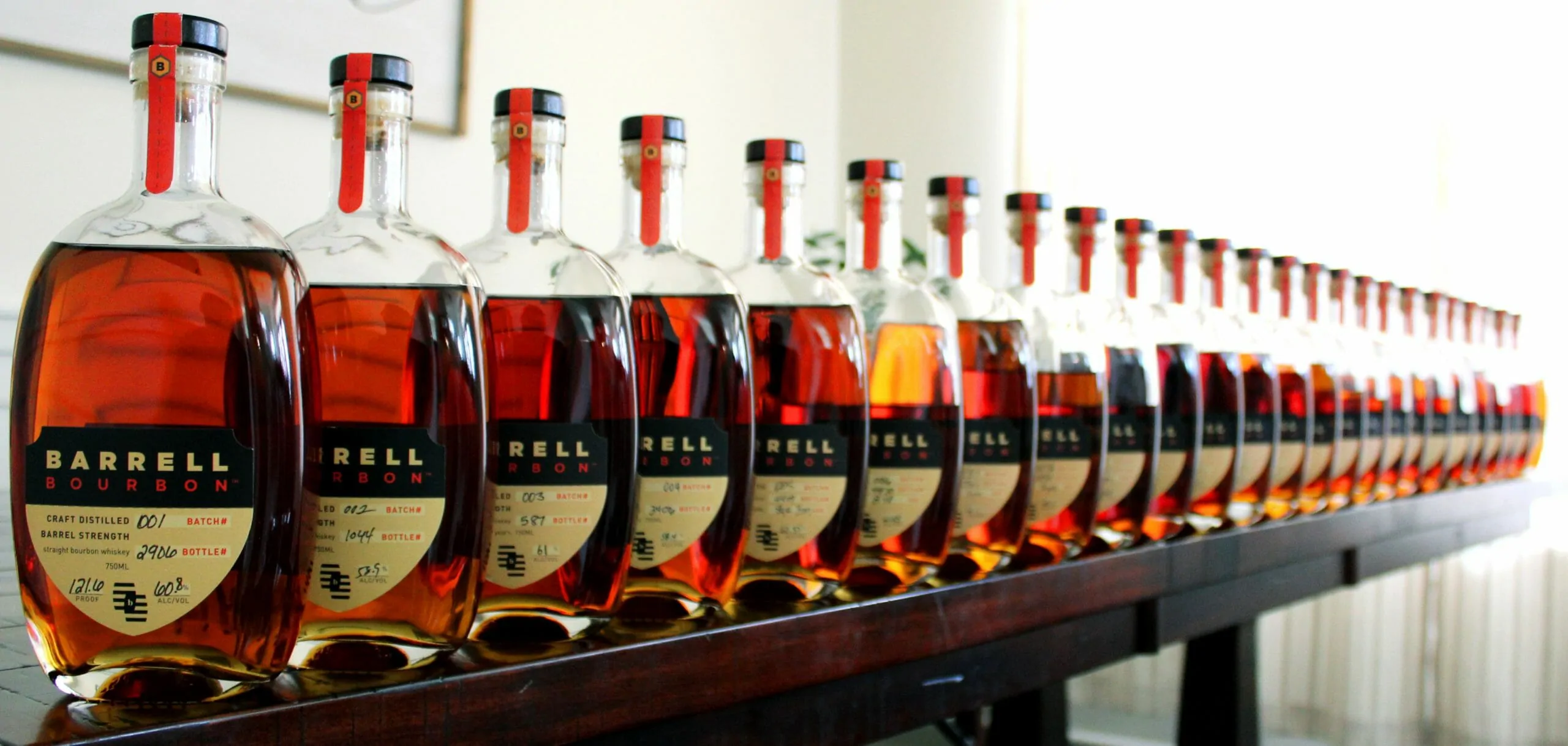| Don't like ads? | No ads |
*Bourbon Culture is reader-supported. When you buy through links on our site, we may earn an affiliate commission.
We’re excited to be the first whiskey review website on the internet to provide in-depth reviews for every single batched release from Barrell Craft Spirits.
BCS first captivated me with their mantra of creating unique batches that were never replicated and were constantly changing.
Whenever you open up a bottle of Buffalo Trace or Wild Turkey, you have an expectation of what you’re going to taste and smell.
But with Barrell Bourbon, each new batch is something different. And that’s the allure of their products; they’re constantly changing.
Origin Story
Barrell’s origin story can be found online throughout multiple articles, but here’s a short recap: Barrell Bourbon was first started by Joe and Jan Beatrice in 2012.
Their first bottling came out in early 2014 with Barrell Bourbon Batch 001. Barrell had a very small team during their formative years, but snagged Tripp Stimson in early 2017 as the Director of Distillery Operations with the goal of eventually distilling some of their own whiskey.
Until distilling would begin, Joe and Tripp appeared to be the primary tongues and noses behind sorting through barrels and blending every batch.
As it stands, one thing that makes Barrell unique is that they source all of their whiskies and rums from various distilleries around the world and then find creative ways to blend them together.
This is not unique in the Scotch Whiskey realm, but was a relatively untried concept at this scale in the US before Barrell started to do it.
Barrell’s transparency is built around the concept that they disclose the states that the barrels are distilled in, aged in, bottled in, the mashbills that they contain, the age of the barrels and the fact that it’s all bottled at cask strength.
Much of this information is sometimes vague though, which probably stems from various NDA’s from the sourcing origin.
Barrell’s Fanbase Expands
All of this wouldn’t mean much without some recognition that what they were bottling was a premium product and justified the premium pricetag, so Barrell began to enter their whiskies into various spirits competitions from the beginning.
The awards they’ve won didn’t go unnoticed either, because with each batch that won big, they quickly vanished off the shelf. To this day, batches like 005, 006, 009, 011, 018 and 021 have a cult following because of the numerous awards they won.
Whenever a particular Batch caught fire, people were quick to rush the stores to buy them. But as with any product that sells out, people try to find the source of that whiskey and then find one that’s very closely related.
This is why once Pappy Van Winkle became such a sought after bottle, the Weller line soon followed. Then consumers became even more obsessed and cleaned out the 1792 Sweet Wheat bottles just because they were affiliated with Buffalo Trace through Sazerac.
But with Barrell, the source of the barrels wasn’t exactly clear.
The Tennessee distiller for most of the batches seemed obvious (Cascade Hollow, makers of George Dickel), but the mashbills were not common.
In fact, the mashbills used in the early, popular batches were downright peculiar. Very little was ever publicly said by Barrell as to the story behind these unique Tennessee bourbon barrels.
This is probably intentional because Barrell doesn’t want any more competition in the marketplace of sourcing barrels.
Barrell also knew that a fanbase was key in getting their whiskey recognized by ordinary folks. This may stem from Joe’s background in sales and marketing and his grasp of how important an image can be. So from the start, they have concentrated heavily on social media as a way to keep influencing others.
This is not new in many of the big distilleries, but Barrell’s Facebook, Twitter and Instagram accounts are very active with everyday drinkers of their products to promoting the local tastings they hold around the US.
They also love to highlight when certain liquor stores have received their shipment of a particular new batch or single barrel selection. This “Grassroots” movement went a long way in getting people to associate their feelings for their hometown liquor store with this new brand.
Very few national-level producers have this level of involvement at the actual point of sale.
Sourcing Barrels: Cost versus Quality
In a recent interview, Joe Beatrice declared that his company has sourced barrels from over 60 producers. Alternatively, Joe has also stated in a separate interview that he will never pay over $3,500 for a barrel of anything because of the economics behind it (and he used to pay much less).
But if you understand anything about the cost of a barrel of whiskey, $3,500 per barrel will not get you the cream of the crop from a distillery. In fact, it may not even get you a middle-of-the-road bourbon at most distilleries.
For example, a barrel of 12 year old MGP bourbon could run you close to $10,000. Most other distillers may charge $7,500 to $9,000 for a fully aged barrel.
But these numbers are not hard-and-fast by any means. Many times, bulk purchases lead to lower prices and sometimes a “Lot” of barrels that have a defect in the eyes of the distiller can also be found for significantly less.
That means to find the sources of his barrels, you have to know a bit more about the cost of barrels around the world and which ones even sell their extra barrels (not all do) to determine what distilleries Barrell sources from.
Barrell Finds Their Cash Cow, Cascade Hollow Distilling Company, home of George Dickel
In 2014, the market for sourced bourbon was still cheap and easy to get into. For a “Merchant Bottler” like Barrell, they had a choice of how they wanted to obtain their barrels.
The first way is to work with a “barrel broker” who acts like a middle-man for sourced barrels. A barrel broker has an inventory that they own from various distillers and presents the merchant bottler with that inventory listed on a spreadsheet.
From there, the merchant bottler can have sample bottles delivered to them to try out before they buy them and have the barrels delivered.
Another technique is to approach the distillery to purchase the barrels directly. The downside to that is you usually have to purchase a large amount in the form of a “Lot” which carries the risk that some of those barrels can be duds (or sometimes empty!).
In 2013/2014, one of the largest untapped sources for all that sourced bourbon was the Cascade Hollow Distillery in Tullahoma, Tennessee.
Cascade Hollow is commonly referred to by many people as simply “George Dickel” or “Dickel.” Spirits behemoth Diageo (more on them later) had come into owning the Cascade Hollow Distillery through a series of mergers sometime between 1994 and 2003.
During this timeframe, the distillery was mothballed because they had produced too much whiskey that wasn’t selling fast enough and their warehouses were stuffed full.
However in 2003, as whiskey consumption began to increase worldwide and their stocks began to dwindle, they finally brought the plant online to distill again.
By the early 2010’s, Cascade Hollow’s warehouses were full of aged and aging bourbon that was available for a very cheap price.
One of the reasons it was so cheap was because it was from Tennessee instead of Kentucky and there was definitely some public stigma that if it wasn’t from Kentucky, it wasn’t good enough.
But even though Cascade Hollow produced Tennessee Whiskey (which is still a bourbon) that still tasted like Tennessee Whiskey, some of the bourbon produced there was experimental and utilized different mashbills that the master distillers had played around with.
These were the barrels that caught the eye (and nose and tongue) of Joe Beatrice.
Everyone knows that Dickel’s standard mashbill is made up of 84% corn, 8% rye and 8% malted barley, but even as Cascade Hollow opened back up in 2003 to fill up depleted stocks, they still had time to distill some unique mashbills.
To put this in context, think of the Buffalo Trace Experimental Collection (BTEC). Buffalo Trace takes time to try all sorts of different mashbills, aging techniques, wood types and much more.
But whereas they sell those experiments to the public in their own branded line, the unique mashbills made at Cascade Hollow are kept there to be sold to NDPs or barrel brokers.
And just like the standard Dickel distillate, it seems that even these experimental batches still go through the Lincoln County Process (LCP) charcoal filtering.
Although not released publicly, there have been a couple of blurbs in online communities from former plant workers that state that after the distilling occurs, there would be no way for the distillate to avoid going from the still to chiller before being dripped through the charcoal.
Cascade Hollow chills all of their distillate to 40 degrees before running it through LCP and into a barrel. This effectively double-filters the whiskey by means of chill filtering and charcoal filtering.
In past interviews with Joe Beatrice, he has talked very little about the early batches that were sourced from Dickel. But in one interview, he indicated that Bourbon Batch 005 (which had a unique mashbill of 70% corn, 26% rye, 4% malted barley) was the product of “barrels made from 1 day of production.”
This would seem to further prove the existence of an experimental distillate out there as being a thing that doesn’t get made often, but when it does, it only gets produced during one day every now and then.
There was also the unique mashbill that was used for the universally loved Barrell Bourbon Batch 009 which consisted of 75% corn, 18% rye, 7% malted barley.
But for the most part, Barrell utilized a particular mashbill from Cascade Hollow that contained 70% corn, 25% rye and 5% malted barley.
The unique high rye content, coupled with the Lincoln County Process, was instrumental in creating a flavor profile unlike anything on the market.
A little known fact is that these unique mashbills are still floating around out there from Cascade Hollow to the right buyers. These experimental mashbills mainly stick with a 70% corn base and tweak the rye and malt percentages.
Typically they are aged for upwards of 8 years. But a reason why you many not see many NDP’s sourcing these unique barrels is because they fetch a premium price of more than 20% of what a standard George Dickel mashbill barrel costs.
So although many companies source barrels from Cascade Hollow, not all of those barrels are created equal.
Now with the story of how Barrell and Cascade Hollow/George Dickel established, let’s turn our attention a little further north from Tennessee to get perspective of some barrels that have also formed the foundation of Barrell Bourbon and their expansion into other forms of whiskey by looking at the history of Seagram’s and the company that ultimately came to own a majority of Seagram’s assets: Diageo.
Understanding this will help to understand the dynamics behind what ultimately shaped Barrell’s future bourbon, whiskey and rye lines.
Seagram’s, Diageo, Four Roses, Bulleit and MGP. How are they all connected?
Seagram’s was a giant conglomeration of distilled spirits brands that dates back from the turn of the 20th century. Skip ahead many decades to the 1990’s and you’ll see they owned, among other things, the Lawrenceburg, Indiana distillery (now MGP Indiana), Bulleit Bourbon in Shelbyville, Kentucky and Four Roses Distillery in Lawrenceburg, Kentucky.
To show how linked together all of these producers were, Four Roses produced (and probably still does) the bourbon used in Bulleit Bourbon while MGP produced the rye whiskey used in Bulleit Rye.
When Jim Rutledge (former Four Roses Master Distiller) dropped a bomb in a Bourbon Pursuit podcast that Four Roses and MGP of Indiana share the same yeast strain (the V yeast strain, made popular by Four Roses), it becomes apparent how closely tied those two powerhouses are.
Even though all three companies are owned by different parent corporations now (Four Roses is now owned by Kirin, Bulleit is owned by Diageo and MPG is the new owner of the Indiana distillery), their history and perhaps more than a few contractual agreements still loosely bind them together.
When you take into account that Diageo owns various whisky distilleries in Canada, Scotland and Ireland as well as their previously discussed ownership of Cascade Hollow Distillery, you can begin to see how their vast portfolio of whiskey (rye, Canadian Whisky, Scotch Whisky, Irish Whisky, American Whiskey and Kentucky Bourbon) fits in perfectly with the products that Barrell puts out.
The Mystery of “Distilled in Kentucky”
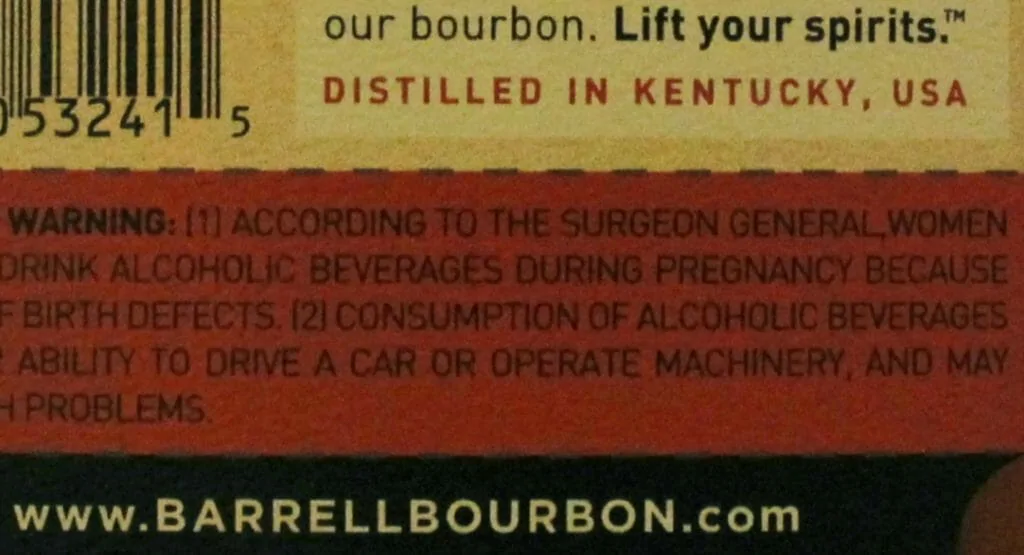
In the early days, Barrell was able to source and release bourbon from an unnamed Kentucky distillery (or distilleries?).
The mashbill for Barrell Bourbon Batch 003 was listed as the same strange mashbill of 70% corn, 25% rye and 5% malted barley that was used in those unique Dickel mashbills. Only this time, it was labeled as “Distilled in Kentucky.”
Also, that mashbill does not line up with any other Kentucky distillery’s standard product mashbill, which means it was probably contract distilled for someone other than Barrell (who wouldn’t have existed when it was originally distilled).
The only clue we have to go by is based on taste. After tasting Bourbon Batch 003 and 004, I’ve concluded that they taste like either a young Four Roses or Barton distillate.
Four Roses is probably a stretch because they were the main suppliers of distillate to Bulleit Bourbon, who was owned by Diageo, but it’s unlikely that Bulleit was sourcing extra bourbon just to sell to a barrel broker.
But one reason why I mentioned Bulleit is because there could be a case to make that when Barrell had agreed to buy such a large amount of Cascade Hollow barrels through a theoretical contract with Diageo, that they also negotiated to buy other Diageo-owned distillery’s barrels on the cheap in the form of a “bulk discount.”
But since this is all speculation that Barrell had a direct contract with Diageo, it makes more sense that these Kentucky-distilled barrels came from Barton.
Barton’s history of contract distilling and low prices would fall right in line with Barrell’s practices.
It is also known that Barton produces some non-standard mashbills for the sole purpose to see what they turn into. I
f they’re good, they’ll become a Barton product, but if they’re not what they’re looking for, they’ll sell the barrels to whoever wants them.
Most websites have published that the standard 1792 ryed bourbon recipe is 75/15/10. But the mashbill that is sourced out to other Non-Distiller Producers is typically a 74/18/8 mashbill.
This is basically the story of how 1792 Sweet Wheat bourbon came to be as well. Barton distilled a large amount of wheated bourbon before their acquisition by Sazerac with no real plans of what to do with them.
But as the bourbon explosion took off, they were able to introduce them into their portfolio.
As Barrell releases each batch since 2017, it’s noted that the sourced barrels from Kentucky would average anywhere from 9 to 15 years old.
That means that these barrels must come from Kentucky distillers who specialize in old, yet cheap bourbon that is readily available.
There are two other likely sources for cheap and old distillate: Jim Beam (think of the inexpensive 15 year old Knob Creek barrels that have been steadily released) or Heaven Hill.
Another highly speculative source that’s not too far from the realm of possible could be distillate from the Old Bernheim warehouses that Diageo plucks barrels for their “Orphan Barrel” line from.
These are all of course, speculation, but you have to follow the money on which distillers sell the cheapest, oldest barrels. And to find that out all you have to do is browse a liquor store to see which brands are bottling the oldest and cheapest cask strength bourbon.
And the answer often boils down to Barton, Bulleit and Jim Beam. But my money is on Barton being the primary source of Barrell’s KY-sourced distillate.
Barrell Releases a Whiskey Line
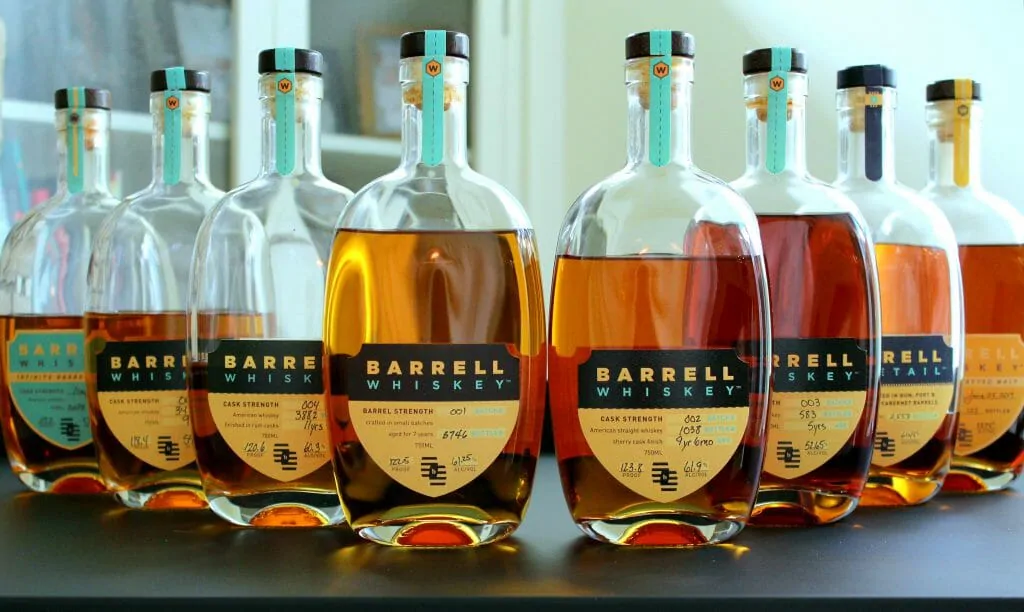
While Barrell’s line of bourbon was rapidly expanding and producing ever-larger batch sizes, the decision was made to start a line of American Whiskey products in 2015. I
n fact, the inaugural batch of whiskey, Barrell Whiskey Batch 001, was sourced from MGP and was a bourbon mashbill that was aged in used bourbon barrels.
But after that release, every batch began to be finished in various casks ranging from various wines to rum barrels to other spirits and liqueurs.
Joe was very adamant to state his personal opinion that once a bourbon entered another barrel to be finished, that he no longer considered it to be a bourbon. Instead, it should be labeled as a whiskey.
Ever since Batch 001, each whiskey batch that Barrell put out utilized the same MGP whiskey or Dickel-sourced Bourbon and whiskey and has used some sort of barrel finish.
The amount and types of finishing barrels that were used became so numerous, that when submitting the label to the TTB for Dovetail, the most recent whiskey at the time of this writing, it was held up due to the fact they were not even sure it could be called a whiskey anymore.
Instead, it was classified as a unique spirit. If you scan the labels on Dovetail, you won’t find it claiming to be a whiskey anywhere on the label.
Barrell gets their hands on MGP Bourbon through an unlikely source
In 2016, Barrell had obtained their first barrels of bourbon that were distilled at MGP in Indiana (they had already began to obtain MGP’s American whiskey the year prior for their Whiskey series line).
Barrell sourced enough MGP bourbon that they were able to make a batch that exclusively contained it: Batch 010. But after reading the fine print on their website, Batch 010’s barrels claimed they were distilled in Indiana, but aged in Michigan.
Once again, there is very little speculation or chatter about the history of these barrels, but my guess is that one of the handful of producers in Michigan that had sourced barrels of MGP bourbon during this time had worked a deal out with Barrell. Or perhaps one of those distillers was off-loading extra barrels to a barrel broker.
The only two distilleries that were releasing sourced MGP bourbon in Michigan at that time were Valentine Distilling (producer of the Mayor Pingree line) or Traverse City Distillery, but we’ll probably never know which one they came from.
My speculation is that when Barrell was searching for the lowest priced MGP bourbon they could find, that they ran across a barrel broker or NDP who offered a “Lot” of various quality barrels at a lower price than if Barrell bought them piecemeal.
This Lot probably consisted of a few high quality barrels that could be sold in Single Barrel form (more on that below), barrels that were just average and could be blended together into batches and then a handful of lower quality barrels that also may have had very low proofs or were over-oaked.
These low-proofed or off profile barrels didn’t faze Joe and his team because he knew they could blend away most of those traits.
Joe recently revealed that in Batch 023, he utilized some 10-14 year old MGP bourbon that was around 80-85 proof (at cask strength!) because it carried some traits that he liked.
So where does that leave the MGP barrels that were deemed excellent enough to be bottled on their own?
When Barrell began to open up their private single barrel program in 2014, their barrels were initially all from Tennessee, but in late 2016, Barrell began to roll out with the single barrel lines that started with either the number 5, 7 or 9.
It is in the “9” series that stores had their chance to pick a single barrel of MGP bourbon that typically averaged around 9 years old.
Barrels 9E51, 9E62, 9E64 and 9E66 were all confirmed MGP barrels that were aged between 8 to 10 years and made the cut to be released as a single barrel. After this though, no further single barrels of bourbon have been confirmed to be from MGP.
Barrell Begins To Dabble In Rye Whiskey
In 2017, Barrell launched a new label for the rye whiskey they had sourced. The first two batches came within quick succession of each other.
For Rye Batch 001, Barrell blended a new mashbill of rye whiskey from MGP (51% rye, 49% malted barley) and Tennessee-sourced rye.
A little known fact about George Dickel Rye Whiskey is that it is actually MGP 95/5 rye whiskey that is distilled and aged in Indiana but then sent to Plainfield, Illinois to go through the Lincoln County Process before it is bottled.
There is actually a little bit of debate into which distillery Barrell is referring to when they put “Distilled in Tennessee” on the back of their Rye whiskey batches.
Because of the aforementioned fact that Dickel does not distill their own rye whiskey and no part of making it occurs in Tennessee, does this mean that Barrell is sourcing Jack Daniel’s or Prichard’s Rye Whiskey for Batch 001 and 003?
My money is on a labeling error and that Barrell wanted to list the rye as being from two different states. It will continue to be an unknown as long as George Dickel Rye bottles continue to say “Distilled in Indiana” on their labels.
As for Rye Batch 002, Barrell again used MGP’s 51/49 rye whiskey and blended it with a 100% Polish rye that was apparently distilled in Poland.
The Polish Rye was briefly discussed in a podcast interview with Barrell as being too strange to stand on its own, but had some wonderful traits that could be blended into another rye to really amp up the flavor.
It was never publicly said, but after Barrell’s attempt into rye batches, they may have found that they were not well received enough to warrant more of their time and money to creating another one.
There are very few, if any, Barrell Bourbon Batches that were released in 2017 or before on any shelves around the nation, but the first two Rye releases can still be found almost 3 years later.
After Batch 002’s release, Barrell went on a 26 month hiatus and did not release any further batched rye whiskey until early 2020 with the release of Rye Batch 003.
At the end of 2018, Barrell joined the ranks of other NDP’s that began to source Canadian Rye Whisky. They began to bottle and release an extension of their single barrel program that would specialize in high proofed, high aged Canadian Rye Whisky.
But whereas American bottlers were mainly utilizing stocks of Alberta Rye Whisky, it has been rumored that Barrell sourced their first barrels of Canadian Rye Whisky from the Gimli Distillery in Manitoba.
This distillery is owned by Diageo and makes distillate for blending into the Crown Royal line of products. These barrels, which were all 13 years old and bore an “L” designation on the label, were noted for their light color and flavor.
But they all excelled in showing off the rye characteristics that were noticeably Canadian with potent herbal and floral characteristics.
In 2020, Barrell began to release 14 year old Canadian single barrel ryes that bore a “V” designation on the label (which we’re assuming means it comes from the Valleyfield Distillery in Canada, also owned by Diageo).
These barrels were much higher in proof across the board, with almost all of them being released above 140 proof. Many fans questioned just what was inside of these barrels that made them so high in proof at such an old age.
The answer seemed to stem from the fact that these Canadian rye whiskies were not all 100% rye content unlike the rye distilled at Alberta.
In fact, a number that gets frequently thrown around is that the rye content of these whiskies is only 53% with the rest being corn.
After much speculation across internet message boards, it is believed that the whiskey in these Canadian barrels were aged in previously used barrels and that the proof that the whiskey was distilled at much higher than the legal limit in the US of 160 proof, and may have been as high as 180 proof (we’re not talking barrel entry proof).
These characteristics would classify it as a Light Whiskey. When Light Whiskey is distilled, it strips away much of the flavor and body of the spirit and leaves a noticeably cleaner and lighter character.
Light Whiskey also typically doesn’t go down in proof as it ages, but instead, increases. This has been noticed in almost all of the old Light Whiskey that is sourced from MGP in the recent years.
And although it is attested that the whiskey in these single barrels is generally excellent, there is a mystery behind how a whiskey that did not start out its life by adhering to the rules and regulations of a rye whiskey in America, still be labeled as such.
No turning back: Barrell Begins To Blend Together Different Distillates
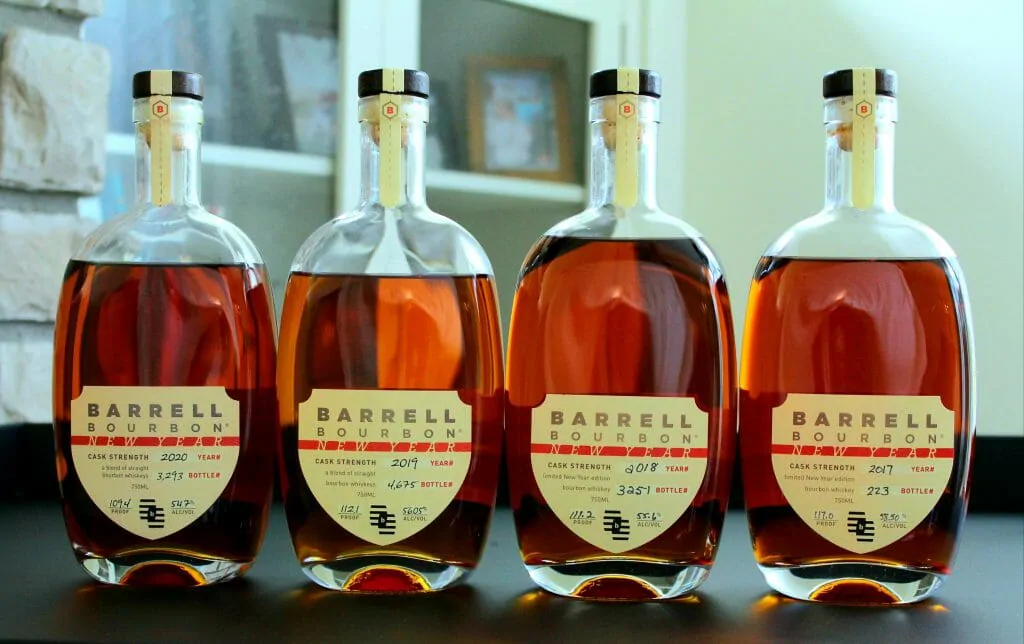
At the end of 2016, Barrell released their first multi-distillery blend of bourbon and called it “New Year 2017.” This concept was untested at this point because Barrell had only blended batches of a single distillery’s product.
But to blend together MGP, Dickel and a Kentucky distillate and get it all to work was impressive and also showed the way to the future.
Early in 2017, Barrell released their Bourbon Batch 013 which blended Dickel and MGP and ever since then, they have been releasing blends just like this.
The New Year batches now integrate various young distillery’s bourbon from states like New York, Texas and Illinois along with their main bourbons sourced from Indiana, Kentucky and Tennessee.
Confident in their blending abilities, Barrell cranked it up to “11” by introducing the Infinite Barrel Project in early 2018 which eventually saw a blending of virtually every whiskey type that they could get ahold of into a giant vat.
Then they’d bottle some of the vat, leaving the rest inside to mingle later on with whatever other whiskey gets added in so that the tank never runs dry.
What’s interesting is that the Infinite Barrel has become Barrell’s entry-level product due to price (low $60 range) and availability (every store that carries Barrell products always seems to have at least one Infinite Barrel bottle on the shelves).
Finally, in 2019 Barrell found a niche in the domestic whiskey market that has been very slow to catch on: the American malt whiskey category.
There are very few domestic companies that produce a malt whiskey (made with at least 51% malted barley) as the concept struggles to lure customers away from established malt whiskies like Scotch and Irish Whisky.
But Barrell found eight different distilleries making malt whiskey to source from and then decided to blend them together to create a new label called “American Vatted Malt.”
The concept of vatting, commonly referred to as “blending” overseas, is not new but it had not previously been done to this scale yet in the US.
And since the market for this type of whiskey was already so small in the US, only time will tell if this project will be deemed a success.
At this point, the only whiskey categories that Barrell has not dabbled in have been Wheat Whiskies or a wheated bourbon. I fully expect to see those in the coming years.
Barrell Bourbon Becomes Barrell Craft Spirits
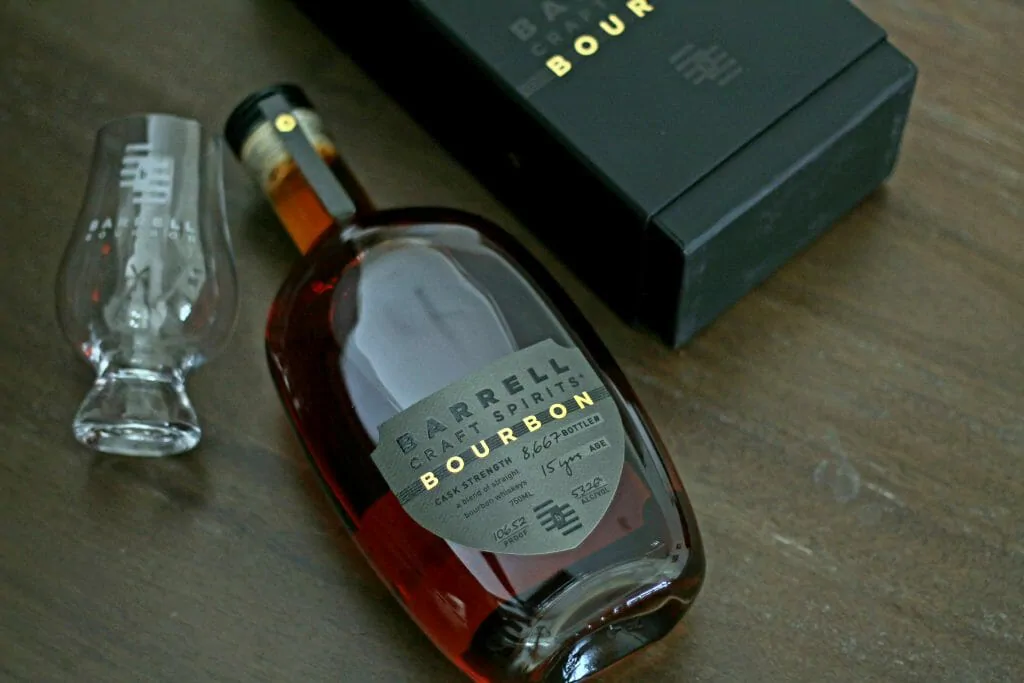
In late 2018, Joe Beatrice and Tripp Stimson cashed in on how well the brand was doing by releasing 3 limited edition bottlings in their new “Barrell Craft Spirits” line: a 15 year old bourbon, a 25 year old American Whiskey and a 13 year old rum.
Priced upwards of $225 retail, these bottlings were meant to symbolize that Barrell had finally made it into the bigtime. The whiskey and rum releases showcased the pinnacle of their blending talents by using the best bourbon and rum barrels that they had set aside throughout their acquisitions.
When these premium products were released, Barrell Bourbon officially switched their name to Barrell Craft Spirits, since the name seemed to align better with their expansion into many other spirits instead of solely bourbon.
The Future of Barrell Craft Spirits
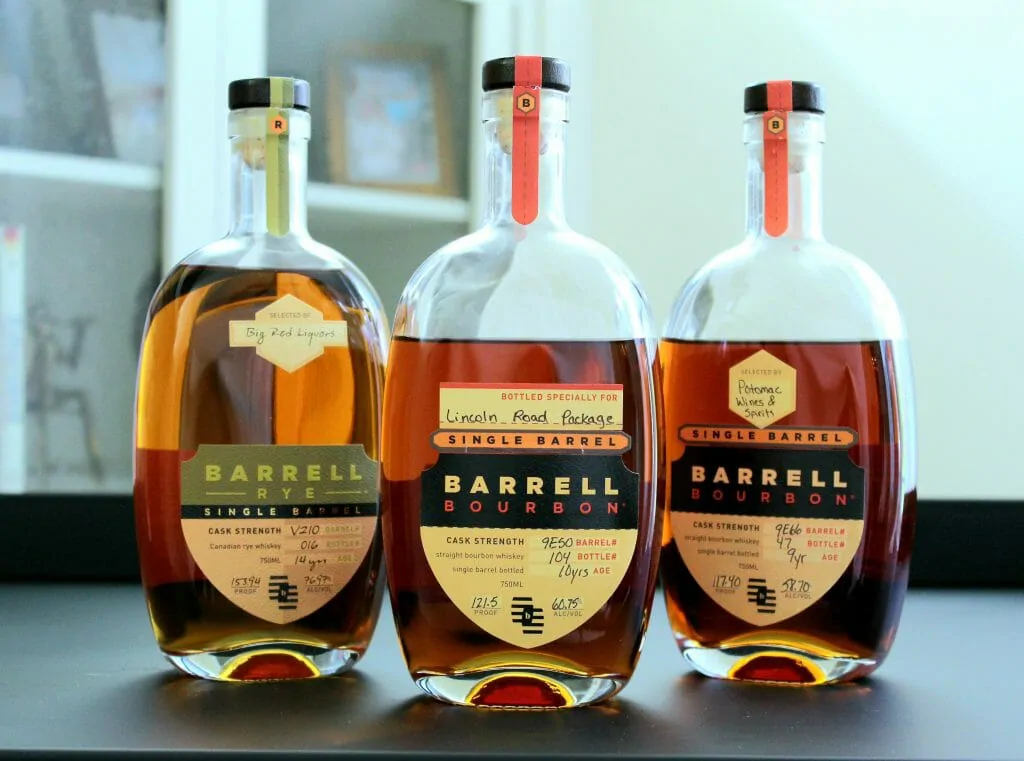
Looking towards the future, Barrell seems to be concentrating heavily on their single barrel program while maintaining their original spirits lines.
In fact, the program is growing so large that they even hired a permanent team member, Nic Christiansen to manage this endeavor that includes private single barrels of Rum, Bourbon, Rye Whiskey and 18 year old American Whiskey (which will bottled in both unfinished form and finished in various wine and spirit barrels).
A steady single barrel program is a logical step to create exclusivity and enhance the image of a premium brand, so this makes sense.
As to what the next steps are, I see Barrell beginning to utilize smaller craft distiller’s aged products in the coming years.
We’ve already seen distillers from Texas, New York and Illinois have their products blended into various Barrell New Year products with success, so I imagine that there are experiments looking into which of those blend best with the other more mainstream distillate that Barrell already has.
As work completes on the still that Barrell is investing in, they will begin to integrate some of their own aged products in with the rest of their sourced barrels to really fine tune whatever profile they want to create.
I even have a prediction that if the bourbon boom continues to expand, that Diageo will eventually make Joe Beatrice an offer he can’t refuse and buy out the Barrell Craft Spirits brand, making it a permanent premium spirits label in their vast portfolio of brands that they own.
It would only make sense as Diageo products represent a large percentage of the barrels that BCS already uses.
A buyout from Diageo would benefit Barrell in lots of ways, but none more significant that the ability to buy their barrels at a cheaper price as well as having the capacity to use other distilleries to produce limited runs of mashbills that Joe wants to concentrate on for future batches.
Although we’ve hated buyouts of other Merchant Bottlers (High West and Belle Meade to name a few), the buying power and persuasion of a large umbrella corporation makes sourcing future barrels much easier, stable and above all else, cheaper.
Barrell still remains a “Merchant Bottler” at heart and has no plans to stop sourcing barrels from other companies according to Joe.
But with endless blending possibilities and a talented team at their disposal, the future seems wide-open to go in whatever direction they choose.
Featured Products
- Neat Traveler

- View Larger
- Description:The Aged & Ore Neat Traveler is a complete travel kit for spirits. We combined our widely praised Neat Glass with one of our 3oz Flight Bottles and housed them together in a custom EVA travel case. Perfect for a night away with your favorite pour. The tie
- Bottle Flight

- View Larger
- Description:The Aged & Ore Bottle Flight is a premium set of 4 custom silicone wrapped glass bottles designed to transport and share samples of your favorite spirits. The flight bottles come in a custom EVA travel case that fits perfectly in any small bag. An Aged &
- Travel Bundle
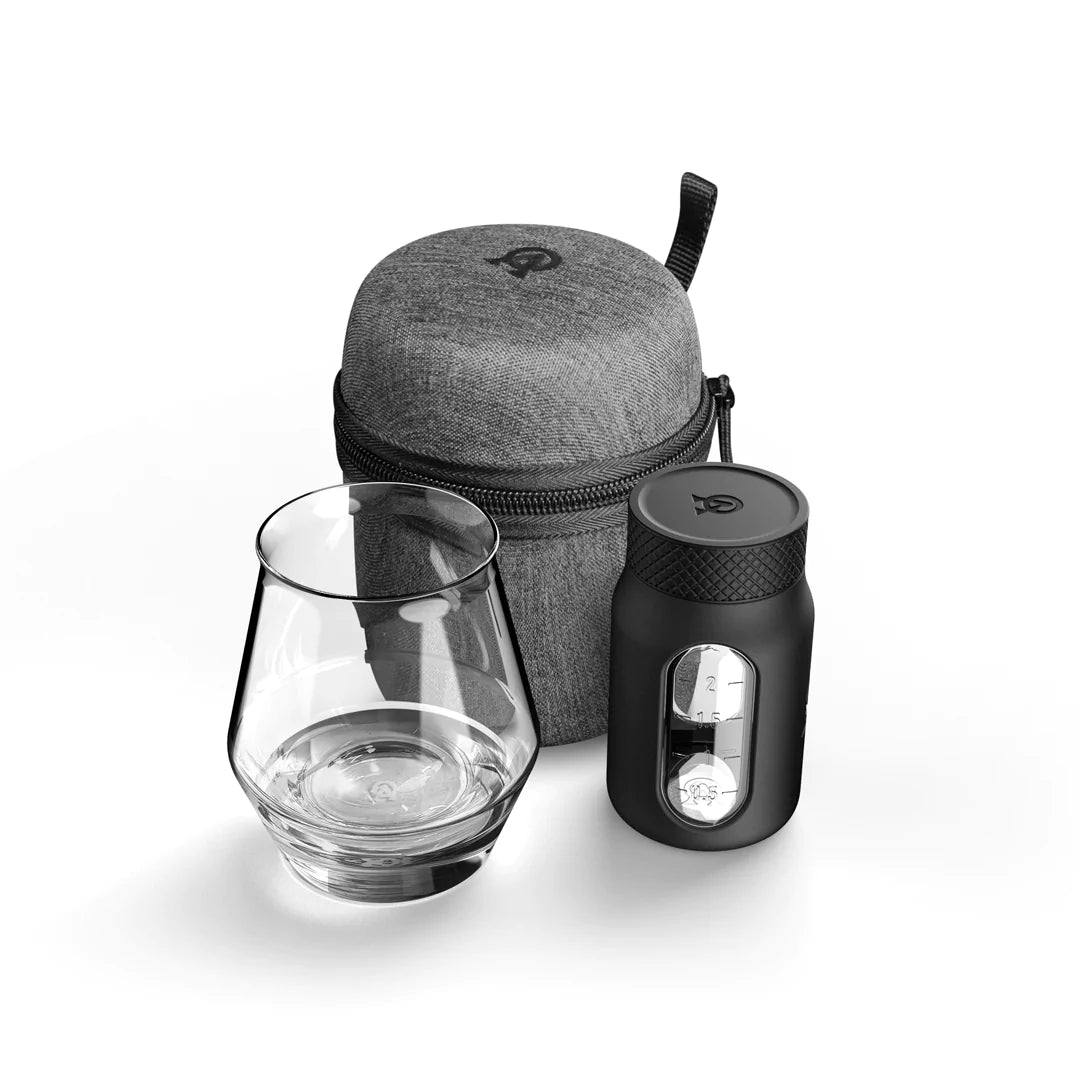
- View Larger
- Description:This Bundle combines two of our crowd favorite products, creating the ultimate travel bundle to bring along your favorite spirits and glassware. Bundle Includes: Neat Traveler (Gray) Bottle Flight (Gray) Note: This bundle is only available in gray and col
*Bourbon Culture is reader-supported. When you buy through links on our site, we may earn an affiliate commission.
